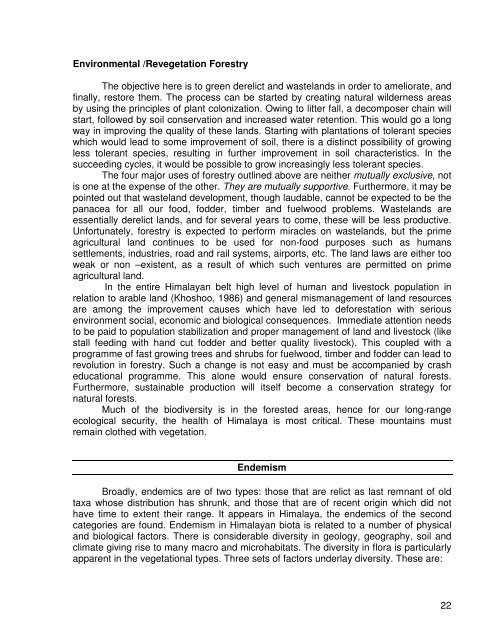Pandit Govind Ballabh Pant Memorial Lecture: II
Pandit Govind Ballabh Pant Memorial Lecture: II
Pandit Govind Ballabh Pant Memorial Lecture: II
Create successful ePaper yourself
Turn your PDF publications into a flip-book with our unique Google optimized e-Paper software.
Environmental /Revegetation Forestry<br />
The objective here is to green derelict and wastelands in order to ameliorate, and<br />
finally, restore them. The process can be started by creating natural wilderness areas<br />
by using the principles of plant colonization. Owing to litter fall, a decomposer chain will<br />
start, followed by soil conservation and increased water retention. This would go a long<br />
way in improving the quality of these lands. Starting with plantations of tolerant species<br />
which would lead to some improvement of soil, there is a distinct possibility of growing<br />
less tolerant species, resulting in further improvement in soil characteristics. In the<br />
succeeding cycles, it would be possible to grow increasingly less tolerant species.<br />
The four major uses of forestry outlined above are neither mutually exclusive, not<br />
is one at the expense of the other. They are mutually supportive. Furthermore, it may be<br />
pointed out that wasteland development, though laudable, cannot be expected to be the<br />
panacea for all our food, fodder, timber and fuelwood problems. Wastelands are<br />
essentially derelict lands, and for several years to come, these will be less productive.<br />
Unfortunately, forestry is expected to perform miracles on wastelands, but the prime<br />
agricultural land continues to be used for non-food purposes such as humans<br />
settlements, industries, road and rail systems, airports, etc. The land laws are either too<br />
weak or non –existent, as a result of which such ventures are permitted on prime<br />
agricultural land.<br />
In the entire Himalayan belt high level of human and livestock population in<br />
relation to arable land (Khoshoo, 1986) and general mismanagement of land resources<br />
are among the improvement causes which have led to deforestation with serious<br />
environment social, economic and biological consequences. Immediate attention needs<br />
to be paid to population stabilization and proper management of land and livestock (like<br />
stall feeding with hand cut fodder and better quality livestock). This coupled with a<br />
programme of fast growing trees and shrubs for fuelwood, timber and fodder can lead to<br />
revolution in forestry. Such a change is not easy and must be accompanied by crash<br />
educational programme. This alone would ensure conservation of natural forests.<br />
Furthermore, sustainable production will itself become a conservation strategy for<br />
natural forests.<br />
Much of the biodiversity is in the forested areas, hence for our long-range<br />
ecological security, the health of Himalaya is most critical. These mountains must<br />
remain clothed with vegetation.<br />
Endemism<br />
Broadly, endemics are of two types: those that are relict as last remnant of old<br />
taxa whose distribution has shrunk, and those that are of recent origin which did not<br />
have time to extent their range. It appears in Himalaya, the endemics of the second<br />
categories are found. Endemism in Himalayan biota is related to a number of physical<br />
and biological factors. There is considerable diversity in geology, geography, soil and<br />
climate giving rise to many macro and microhabitats. The diversity in flora is particularly<br />
apparent in the vegetational types. Three sets of factors underlay diversity. These are:<br />
22











